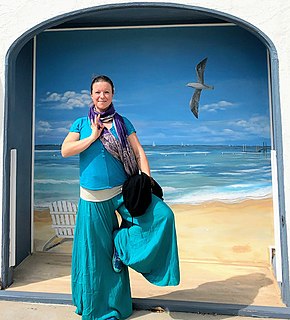Related Research Articles

Software architecture refers to the fundamental structures of a software system and the discipline of creating such structures and systems. Each structure comprises software elements, relations among them, and properties of both elements and relations. The architecture of a software system is a metaphor, analogous to the architecture of a building. It functions as a blueprint for the system and the developing project, laying out the tasks necessary to be executed by the design teams.
Michael Anthony Jackson is a British computer scientist, and independent computing consultant in London, England. He is also a visiting research professor at the Open University in the UK.
In software development, a traceability matrix (TM) is a document, usually in the form of a table, used to assist in determining the completeness of a relationship by correlating any two baselined documents using a many-to-many relationship comparison. It is often used with high-level requirements and detailed requirements of the product to the matching parts of high-level design, detailed design, test plan, and test cases.

In systems engineering and software engineering, requirements analysis focuses on the tasks that determine the needs or conditions to meet the new or altered product or project, taking account of the possibly conflicting requirements of the various stakeholders, analyzing, documenting, validating and managing software or system requirements.

Ariane flight V88 was the failed maiden flight of the Arianespace Ariane 5 rocket, vehicle no. 501, on 4 June 1996. It carried the Cluster spacecraft, a constellation of four European Space Agency research satellites.
In product development and process optimization, a requirement is a singular documented physical or functional need that a particular design, product or process aims to satisfy. It is commonly used in a formal sense in engineering design, including for example in systems engineering, software engineering, or enterprise engineering. It is a broad concept that could speak to any necessary function, attribute, capability, characteristic, or quality of a system for it to have value and utility to a customer, organization, internal user, or other stakeholder. Requirements can come with different levels of specificity; for example, a requirement specification or requirement "spec" refers to an explicit, highly objective/clear requirement to be satisfied by a material, design, product, or service.

Simulink is a MATLAB-based graphical programming environment for modeling, simulating and analyzing multidomain dynamical systems. Its primary interface is a graphical block diagramming tool and a customizable set of block libraries. It offers tight integration with the rest of the MATLAB environment and can either drive MATLAB or be scripted from it. Simulink is widely used in automatic control and digital signal processing for multidomain simulation and model-based design.
Requirements management is the process of documenting, analyzing, tracing, prioritizing and agreeing on requirements and then controlling change and communicating to relevant stakeholders. It is a continuous process throughout a project. A requirement is a capability to which a project outcome should conform.
In software engineering, behavior-driven development (BDD) is an agile software development process that encourages collaboration among developers, quality assurance testers, and customer representatives in a software project. It encourages teams to use conversation and concrete examples to formalize a shared understanding of how the application should behave. It emerged from test-driven development (TDD). Behavior-driven development combines the general techniques and principles of TDD with ideas from domain-driven design and object-oriented analysis and design to provide software development and management teams with shared tools and a shared process to collaborate on software development.
Problem analysis or the problem frames approach is an approach to software requirements analysis. It was developed by British software consultant Michael A. Jackson in the 1990s.
In requirements engineering, requirements elicitation is the practice of researching and discovering the requirements of a system from users, customers, and other stakeholders. The practice is also sometimes referred to as "requirement gathering".

A view model or viewpoints framework in systems engineering, software engineering, and enterprise engineering is a framework which defines a coherent set of views to be used in the construction of a system architecture, software architecture, or enterprise architecture. A view is a representation of a whole system from the perspective of a related set of concerns.

Behavior trees are a formal, graphical modelling language used primarily in systems and software engineering. Behavior trees employ a well-defined notation to unambiguously represent the hundreds or even thousands of natural language requirements that are typically used to express the stakeholder needs for a large-scale software-integrated system.
Cross-impact analysis is a methodology developed by Theodore Gordon and Olaf Helmer in 1966 to help determine how relationships between events would impact resulting events and reduce uncertainty in the future. The Central Intelligence Agency (CIA) became interested in the methodology in the late 1960s and early 1970s as an analytic technique for predicting how different factors and variables would impact future decisions. In the mid-1970s, futurists began to use the methodology in larger numbers as a means to predict the probability of specific events and determine how related events impacted one another. By 2006, cross-impact analysis matured into a number of related methodologies with uses for businesses and communities as well as futurists and intelligence analysts.
Sir Anthony Charles Wiener Finkelstein is a British engineer and computer scientist. He is the President of City, University of London. He was Chief Scientific Adviser for National Security to HM Government until 2021.
Axel van Lamsweerde is a Belgian computer scientist and Professor of Computing Science at the Universite catholique de Louvain, known for his work on requirements engineering and the development of the KAOS goal-oriented modeling language.
The Open Energy Modelling Initiative (openmod) is a grassroots community of energy system modellers from universities and research institutes across Europe and elsewhere. The initiative promotes the use of open-source software and open data in energy system modelling for research and policy advice. The Open Energy Modelling Initiative documents a variety of open-source energy models and addresses practical and conceptual issues regarding their development and application. The initiative runs an email list, an internet forum, and a wiki and hosts occasional academic workshops. A statement of aims is available.
Architecturally significant requirements are those requirements that have a measurable effect on a computer system’s architecture. This can comprise both software and hardware requirements. They are a subset of requirements, the subset that affects the architecture of a system in measurably identifiable ways.
Designers have used computers for calculations since their invention. Digital computers were used in power system analysis or optimization as early as proto-"Whirlwind" in 1949. Circuit design theory or power network methodology was algebraic, symbolic, and often vector-based.

Birgit Penzenstadler is a German assistant professor of Software Engineering at Chalmers University of Technology and adjunct docent at Lappeenranta University of Technology. She is well known for her work on environmental sustainability in software engineering and for being one of the founders of the sustainability design initiative, which seeks to advance the research on sustainability in technical disciplines such as computer science and software engineering.
References
- 1 2 RESG website Archived 2011-11-12 at the Wayback Machine Retrieved 29 October 2011
- 1 2 3 About the RESG Archived 2012-02-07 at the Wayback Machine Retrieved 29 October 2011
- ↑ Al-Karaghouli, Wafi; Taylor, Peter; AlShawi, Sarmad. (May 25–26, 2008). "Knowledge Management: Using A Knowledge Requirements Framework To Enhance Uk Health Sector Supply Chains" (PDF). European and Mediterranean Conference on Information Systems. Al Bustan Rotana Hotel, Dubai: 2. Archived (PDF) from the original on 2012-04-25. Retrieved 2011-10-28.
- ↑ "Orlena Gotel". Archived from the original on 2013-02-26. Retrieved 2012-07-24.
- 1 2 Newsletter RQ01 Archived 2012-04-25 at the Wayback Machine Retrieved 29 October 2011
- 1 2 RESG Events Archived 2012-02-07 at the Wayback Machine Retrieved 29 October 2011
- ↑ Justin Richards. Requirements Engineering Symposium Archived 2022-07-09 at the Wayback Machine Computer Weekly. 20 April 2006.
- ↑ Farmer, Johannes; Lindstaedt, Stephanie; Droschl, Georg; Luttenberger, Peter. "Ad Hoc - Technology-Supported Learning" (PDF). Ad Hoc – Work-Integrated Technology-Supported Teaching And Learning. p. 12. Archived (PDF) from the original on March 4, 2016. Retrieved October 28, 2011.
- 1 2 3 Newsletter Archived 2012-02-07 at the Wayback Machine Retrieved 29 October 2011
- ↑ RENOIR newsletter 44 Archived 2006-05-02 at the Wayback Machine Retrieved 29 October 2011
- ↑ Emmerich, Wolfgang; Sawyer, Pete (1996). "Guest Editorial". Requirements Engineering. 3 (2): 71–72. doi:10.1007/BF02919964.
- ↑ Justin Richards. Event offers expert advice on using scenarios Archived 2009-09-25 at the Wayback Machine Computer Weekly. 17 January 2006.
- ↑ Justin Richards. Service-based systems in the spotlight Archived 2022-07-09 at the Wayback Machine 23 February 2007.
- ↑ Michael Jackson. Problem Frames: Analysing and Structuring Software Development Problems. Addison-Wesley, 2001. ISBN 0-201-59627-X